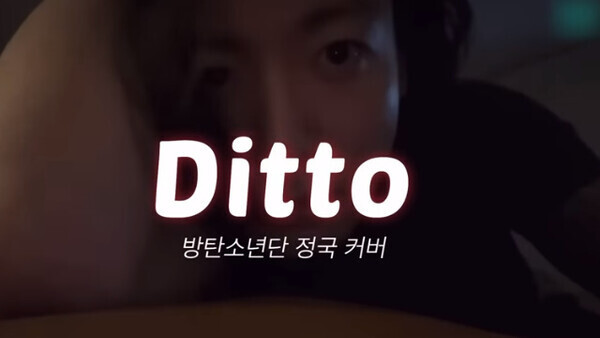BTS Jungkook: Soothing Souls Through Song Covers
The concept of a 'cover' in pop music refers to the act of performing someone else's song, instrumental, or dance, often in homage to an artist one admires. Essentially, a cover can be seen as an artistic reconstruction, a personal confession of taste and style. Naturally, it includes the performer's interpretation, which occasionally can even surpass the popularity of the original. Genres such as classical and jazz have long considered the cover as a form of creation. Notable examples for me include Kim Kwang-seok's reimagined songs in the album 'Again Singing', as well as Rufus Wainwright and Michael Jackson's renditions of Beatles songs. Most covers feature well-known or popular songs, making them commercially stable and enticing for producers. This is why cover albums and song covers in auditions or survival programs are continuously exposed to the public.
However, what we will delve into here is slightly different. It's about covers performed solo (or occasionally as a duet), more specifically the trend of professional singers, not 'cover specialists' like J.Fla or Pentatonix, singing songs they couldn't or wanted to perform through their personal YouTube channels. It's beneficial for the singers as it offers practice and a chance to indulge their personal interests. Meanwhile, listeners enjoy seeing a different side of their favorite stars and hearing varied interpretations of past hits. This practice might seem similar to Dingo Music's 'Killing Voice' or a combination of 'ODG Karaoke' where someone performs a song for an audience. However, the fact that these songs are posted on the singers' personal channels differentiates them as 'covers.' While 'ODG Karaoke' caters to a single student, these cover videos, like 'Killing Voice,' are directed at a general audience. Nevertheless, the emotional resonance one feels when a friend sings a favorite song at a karaoke is akin to watching these cover videos.
The trend of artists covering songs started years ago and continues to this day. Some artists maintain this practice regularly, while others have become less frequent or have ceased entirely due to other commitments. For instance, Lim Young-woong, who uploaded around 90 cover videos on his channel, has virtually stopped uploading four years ago, possibly due to his drastically changed status over a few years. Kim Bum-soo, who consistently posted cover videos through 'Beum Karaoke,' has also been less active recently. Lee Su-hyun from Akmu, despite having a separate playlist labeled 'covers,' doesn't seem very active in updating it. Lee Hae-ri from Davichi, renowned for her cover skills, tends to repurpose her past covers from performances and TV shows rather than creating new videos. While the cover activities of these singers could have been a necessary choice during pandemic restrictions or used as an encore in concerts, they mainly stem from the joy they find in performing, highlighting the intrinsic value of covers. Among them, BTS's Jungkook stands out.
Last May, Jungkook held a personal live broadcast on the fan community platform Weverse, sporting large glasses and a humble demeanor. During this broadcast, he discussed and sang 'NIGHT DANCER' by the J-pop musician imase, a song that gained popularity through a TikTok dance challenge (with over 1.2 billion views). The song cover was natural for Jungkook, who has a history of covering both domestic and international songs, from Park Hyo-shin's 'A Night When Cold Wind Blows' to Adam Levine's 'Lost Stars.' However, given that he's a BTS member whose cover of 'Falling' attracted 65 million views a year ago, the impact of his song cover is incredibly significant. What's more, in this era where any form of information is immediately spread and instantly consumed, the artistry of Jungkook's covers, especially their 'long-lastingness', stands out even more.
In the past, some of BTS's cover videos became controversial due to the vast power of ARMY (BTS's fan club). For instance, when Jungkook's cover of 'Falling' surpassed the original song by Harry Styles in views, it sparked a debate about whether such an outcome was fair. However, rather than getting embroiled in these disputes, what we need to focus on is Jungkook's cover strategy, which is more than just a matter of showing off his skills or displaying another aspect of his persona.
Jungkook's cover of 'NIGHT DANCER' is a good example. When we think about popular J-pop musicians, names like Namie Amuro, Arashi, Hikaru Utada, or Kenshi Yonezu come to mind. However, it was a surprise that Jungkook covered imase, who is less known than these names, at least to the international audience. While the song had gained considerable attention on TikTok, it didn't show significant chart performance. This shows that Jungkook doesn't simply choose popular songs to cover but instead selects songs that resonate with him personally, regardless of their popularity status.
The cover song doesn't just showcase Jungkook's vocal prowess, but it also broadens his and BTS's musical horizon, showing an interest in various genres. In the past, he has covered songs from pop, R&B, and even ballads. The cover of 'NIGHT DANCER', with its dance-pop genre, allowed Jungkook to further extend his musical scope. Moreover, it signifies his interest in the J-pop genre and promotes cultural exchange between Korea and Japan.
Finally, let's consider the fact that he chose to perform this cover during a live broadcast, rather than posting a pre-recorded video on YouTube. The interactive nature of the live broadcast allows for an immediate connection with fans. Fans can instantly express their thoughts and reactions, forming a closer bond with the artist. This approach not only facilitates immediate feedback but also humanizes Jungkook, offering fans a glimpse of his personality and taste in music.
Lee Ji-hye, a former member of the group S#ARP, consistently shares cover song videos on her channel, aptly named 'Unresentful Attention-Seeker Unnie's Music Life'. What stands out on her channel is her preference for covering songs by junior artists such as Younha, Akdong Musician (AKMU), NU'EST and IVE. Her most recent video featured a duet with Chae Jeong-an on IVE's 'Kitsch', highlighting her enduring passion for music beyond her apparent shift towards variety shows. These covers serve as a bridge not just between the singer and the listeners, but also between senior and junior artists. The satisfaction derived from rediscovering oneself through such projects is merely a bonus.
Quality cover videos can sometimes even lead to official music releases, as is the case with Lee Hong-gi from FT Island. About three to four months ago, he shared cover videos of Sung Si-kyung's 'Hee Jae' and Lee Seung-gi's 'Delete' on his YouTube channel, 'Hongki Jongki'. Thanks to the overwhelming support and fervor from the viewers, he officially released these covers as music singles on June 14. This isn't merely a casual hobby; it's a calculated business move, resulting from careful discussion and requiring the original artists' permission. While it can be challenging to predict the success of such cover music or albums, Lee Hong-gi's case can serve as a useful reference for artists and planners considering releasing cover works in the future.
While cover videos can often be a showcase of personal achievement, like in Lee Hong-gi's case, they can also elevate to a level of public service. Since 2018, singer Ju Hyun-mi has been running her YouTube channel, 'Ju Hyun-mi TV', which currently boasts over 200,000 subscribers. She regularly covers old songs, treating it like a critical review of the songs with her voice. Additionally, she writes about these songs and even compiled them into a book, providing both entertainment and knowledge to her audience.
Jung Eun-ji, who released a remake album 'Log' last year, is another artist who regularly uploads cover videos for her 450,000 subscribers. One video she uploaded a month ago particularly resonated with her audience. She sang YB's 'White Whale' in sign language, expressing her desire to convey the "message and power" of the song in a different way. For the modern individual, often forgetting the value of living together in the fast-paced world, Jung Eun-ji aimed to convey the "message and power" inherent in the song, one careful sign at a time. Sometimes, a song cover can warm a listener's heart that has grown cold under the weight of life, providing comfort in a wholly unique way.
- BTS's Suga Speaks Out on Hallyu Ban, Sparking Buzz
- BTS 10-Year Anniversary Event Expected to Draw '300,000 Fans'; Prime Minister Emphasizes 'Full Safety Management'
Copyright © 2023 Kpop Reporter. All rights reserved. Do not reproduce without permission.











